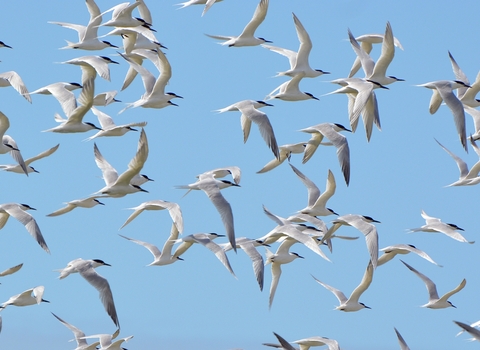Seabird Spectacular
For a brief few months Cemlyn Nature Reserve is home to one of the most amazing seabird spectacles in Wales. Follow the terns as they return from their wintering grounds to raise a new family and learn all about the ups and downs of life in a tern colony. Read about how the Sandwich terns are getting on, discover how the summer differs for the common and Arctic terns. And keep up to date with news about unusual bird sightings!
2025
The new tern season is underway and we will keep you up to date on how the terns are get on, along with news about other wildlife sightings around Cemlyn.
March 2025
Through the month of March, Wildlife Trust and staff were busy getting the reserve ready for the arrival of the terns. As the month ended the first Sandwich terns were seen around the Bay.

© NWWT
2024
Here's all the news about the terns and wildlife sightings in and around Cemlyn from Summer 2024
August 2024
The end of another season....
...and what a season it has been! Following the challenges of 2023, it has been such a joy to have seen the colony so healthy and productive this year. About 2000 Sandwich tern, 200 common tern and 400 arctic tern chicks fledged this year, as well as chicks of other species across the reserve, which is incredible.
We want to say a massive thank you to our wonderful volunteers who collectively have given over 200 hours of their time, protecting and monitoring the colony and talking to our visitors - you're amazing!
Thank you also to everyone who has visited and supported the colony and the reserve in a variety of ways.
The terns have now left Cemlyn but you may still catch them around the North Wales coast, before they embark on their long journey south. And look out for the orange leg flags!
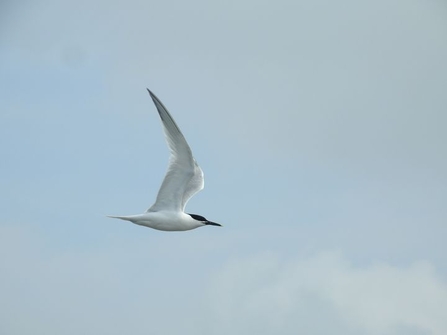
Tern at Cemlyn Nature Reserve © Hannah Smith
July 2024
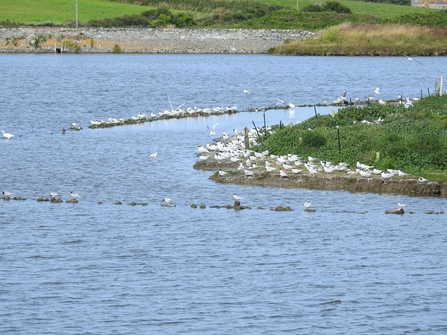
Cemlyn Nature Reserve terns © Hannah Smith
28th July The end of the season is quickly approaching and the islands have really emptied out. Only about 20 each of common and Arctic terns, and between 100 -150 Sandwich terns, remain. Those that are here have taken up standing at the back of the island so views from the ridge are now very limited! After months of so much noise and constant movement, the relative quiet is very strange.
However, a flock of up to 100 curlew is now a regular feature in our neighbouring fields. Numbers of egrets are building, as they do at this time of year, having left their breeding grounds. Flocks of linnets, meadow pipits and goldfinches are gathering around the reserve too.
18th July About two thirds of the tern colony have now left - both adults and fledglings. Those that remain have spread out across the reserve. There are still about 50 chicks that haven't fledged yet, but there is still plenty of time for them to do so. The pair of Mediterranean gulls on the large island have fledged one chick, which is surprisingly illusive, but can often be seen around the lagoon.
11th July Excellent news! Three tiny ringed plover chicks hatched today and have been finding their feet amongst the pebbles. Both parents are looking after them although they're very independent already. Ringed plovers benefit from having the roped off area on the ridge - not only does it keep our terns happy and undisturbed, but it also provides a place for other ground nesting birds to breed, safely away from feet and paws!
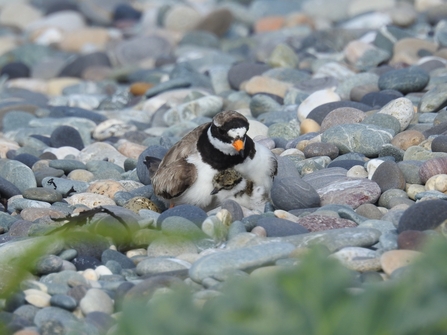
Ringed Plover and chick at Cemlyn ©Hannah Smith
9th July Our Sandwich tern chicks are now well and truly airborne! The colony has been very mobile this week, with all the birds flying around the lagoon several times a day, with only a few birds remaining on the ground during this time.
A few of the colour flagged Sandwich tern juveniles have been seen on the Clwyd! There is still a lot we don't know about the post-fledgling dispersal and colour flagging is helping to build up a picture of where they go. If you're near the coast, keep your eyes peeled!
Elsewhere on the reserve, 5 red-breasted Merganser chicks hatched earlier this week. They are growing fast and can be seen splashing their way across the lagoon!!
4th July The latest Sandwich tern chick count reached 1690, and many of these are now airborne around the islands. Plenty of wing flapping and jumping is also happening, although some are still struggling to get enough lift to go very far!! The are about 78 Arctic tern chicks and 22 Common tern chicks too. Plenty more adults are still sitting in nests so we're expecting these numbers to grow. A few of the Arctics are very confident fliers and can be seen exploring the seaward side of the ridge, still being well attended by their parents.
310 Black-headed gull fledglings were counted, and many of these have been seen venturing further afield around the reserve. However, there were some tiny fluffy chicks seen today, having only just hatched!
1st July The weather continued to disappoint but there is always some wildlife to see and cheer the soul. A hedgehog searching for food seemed oblivious to the drizzle!
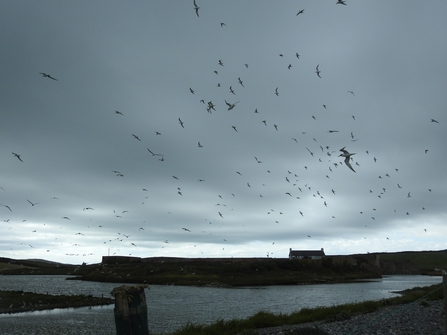
Cemlyn Nature Reserve terns © Hannah Smith
June 2024
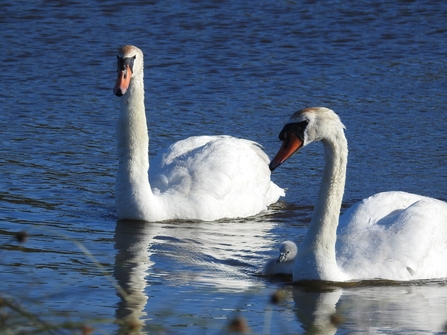
Swans and cygnet Cemlyn © Hannah Smith
June 28th A single cygnet is a new addition to the many young birds around the reserve.
June 25th Over 1,000 Sandwich chicks are now visible, with perhaps many more hidden away still or yet to hatch. Plenty of sand eels are being brought in and now that the chicks are bigger, so is the food! We've also counted 280 Black-headed gull chicks and fledglings - most of these are now flying short distances, but are still staying close to their parents. The common and arctic terns are doing well too - they're a bit behind the sandwich terns, but we've seen at least 70 'commic' tern chicks.
Elsewhere around the lagoon and ridge the oystercatcher chicks are growing up fast but are still being well looked after by their parents. Despite their name, they don't really eat oysters, instead eating mainly cockles, mussels or worms. Individuals specialise in different food types, and the chicks will learn how to feed from their parents
June 20th There are now hundreds of tern chicks on the islands. They are very mobile, growing by the day and constantly hungry. We've seen lots of wing flapping and stretching, but we're still a week or so off the oldest ones taking flight for the first time. Yesterday 139 Sandwich Tern chicks were given a metal leg ring and an orange flag, both with a unique code to them (see photo below). This is a really important source of data, enabling us to know where our terns go after they leave us in July. It helps us monitor population health and informs how best to help terns, on a global scale, not just here at Cemlyn. And it means we know that some come back to breed here after reaching maturity! Other tern colonies have different colour ringing schemes, of which we've seen many this year. Terns from all over the UK and Ireland, and the Netherlands have all been seen here, showing that Cemlyn has a big draw. This dataset is something that everyone can contribute to - by looking out for and reporting any of our orange flagged birds when they leave here at the end of the season. All ringing is done under licence by experienced and skilled ringers.
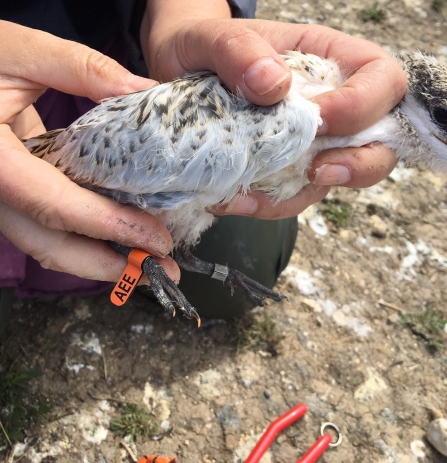
Sandwich tern ringing © Phil Woollen (Taken under licence issued by Natural Resources Wales)
June 13th Today was more like February than June, but the terns have been carrying on regardless, battling 45mph winds to bring in sand eels to the islands and the constantly hungry chicks waiting for them, beaks open. There are still lots of adults sat on eggs but everywhere you look there are chicks scuttling around, stretching and growing at impressive speeds!
June 7th Our annual colony count, conducted under a licence from NRW, is a vital part of monitoring the health of the colony and this year, and this year it is great news! Altogether we counted over 2,000 pairs of Sandwich terns, 210 pairs of Arctic tern and 90 pairs of Common terns nesting across the two islands! This is wonderful news following the avian flu outbreak last year, and our numbers are almost at what they were in 2022. More chicks are hatching every day and the older ones are venturing further from their parents, making them easier to spot. Adults of all species are busy bringing back sand eels, with a constant stream of terns over the ridge.
June 5th We've recorded more than 15 species of wader this season, including breeding oystercatcher. Turnstone, ringed plover and dunlin often feed on the tideline and we've even had a few visiting curlew sandpiper!
June 1st The first Sandwich tern chicks were seen today. At the moment they're quite camera-shy. The parents are doing a wonderful job at keeping them warm and protected, so we only got glimpses when they popped their tiny heads out to be fed. They will get more visible as they get bigger and more mobile, and as more hatch over the coming days.
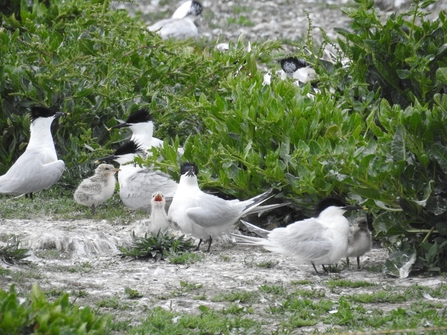
Sandwich terns at Cemlyn © Hannah Smith
May 2024
May 26th A red-rumped swallow visited Cemlyn this weekend. They are usually found in Southern Europe during the summer, but sometimes they overshoot when migrating from tropical Africa in the spring. This is only the third official record for Anglesey and the first since 2008!
May 23rd A wild day! The high tide almost reached our usual colony-watching spot on the ridge, with waves, sea spray and wind greeting the few brave visitors who made it out today. Whilst the growing number of black-headed gull chicks have been hunkered down out of the wind, the terns have been battling the elements, as have other birds around the reserve. News of the general election and the local prominence given to reports of a possible new nuclear power proposal at Wylfa reminded us of battles past and to come. In the talk of jobs and finances, it is also worth remembering that back in 2019, at the end of the public enquiry into the proposed Wylfa development, the Planning Inspectorate concluded there was a lack of scientific evidence put forward to show that the Arctic and Sandwich tern populations at nearby Cemlyn, would not be disturbed by the construction. There were fears that these birds would subsequently abandon their breeding grounds at Cemlyn as a result. In addition, expert planning officers felt that the scheme would fail to meet some of the United Nations' biological diversity standards. While the 2024 season rolls on we will keep a watchful eye on other developments.
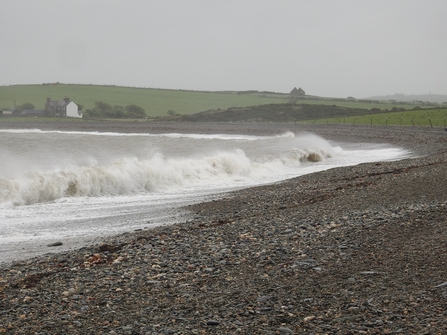
High Tides and Storms at Cemlyn May 2024 © Hannah Smith
May 16th The first black-headed gull chick hatched today! Both parents share caring responsibilities, including incubating the remaining two eggs in the nest and ensuring that the chick is fed, warm and dry.
May 12th The islands have become noticeably busier (and noisier!) this week - we now have over 2,000 Sandwich terns, 250 Arctic terns and 150 Common Terns. About 750 Sandwich terns are now sitting on eggs. Both parents share the incubation so it is possible to see the eggs when the adults swap over or shift position! There are also 160 Black-headed gulls on nests
May 8th Most evenings now the number of Sandwich terns roosting is reaching over 4,000 birds; about 70 birds look like they are now sitting on nests. This is roughly the same as last year for the number of sitting birds, but higher for roosting birds. Common and Arctic terns are also present in good numbers and very visible on the bricks. Up to 3 pairs of Mediterranean gulls have been seen. And we saw a splendid red kite overhead this morning.
May 3rd With the spring migrations in full swing, numbers of all tern species are building up and we have also heard sedge warblers and grasshopper warblers. But a highlight of the last few days has been a wood sandpiper and a pair of curlew sandpiper; one of the latter was just coming into summer plumage and was a good contrast to the winter plumage bird.

Curlew sandpiper in winter and summer plumage at Cemlyn © Hannah Smith
April 2024
April 30th The Sandwich terns are building in numbers and performing their wonderful courtship displays. There are a few more common terns around as well. A wood sandpiper was also showing well.
April 20th The first common tern was spotted today and a pair of Mediterranean gulls appear to be nesting
April 12th A big hello and welcome back to Hannah and Mark, who return for another season as wardens at Cemlyn. One of their first jobs was clearing up after Storm Pierrick. The storm smashed waves into the shingle ridge dislodging many of the posts and rope. Wardens an important part of managing the many visitors to Cemlyn and help prevent disturbance to the tern colony. As they worked, the first of this year's Sandwich terns roosted on the islands. Out in the lagoon summer regulars, shelduck and red-breasted merganser, bobbed about.
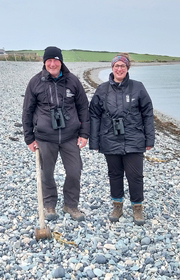
NWWT Chris Wynne
March 2024
The last weeks of March saw staff and volunteers make the preparations for a new tern season at Cemlyn. The weir boards were installed, ridge posts and rope put out to help manage the many visitors and nest boxes and fence installed on the islands. There was the added treat of a pair of snow buntings on Trwyn Cemlyn and the sight of a large flock of golden plover. Photo Freya Ryan
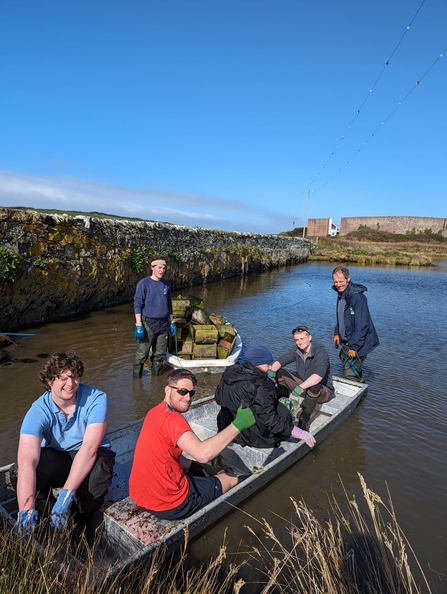
Volunteers at Cemlyn © NWWT
Summer 2023
Here's how things went at Cemlyn in 2023
August 2023
August 6th There are now only about 200 adult and 30 fledgling terns left on the islands, most of them on the small island and the beach. It won’t be long now until the lagoon is quiet once more… Look out for them moving up and down the coast, feeding up before their long migration.
However, the reserve will still have its Autumn and Winter residents! Lots of Curlews are moving down from their summer breeding grounds – we’ve seen groups of over 100 this week! We have also sighted Sanderling, Redshanks and large flocks of Linnets and Starlings.
We are also happy to inform you that the Shelducks and Ringed plovers have fully fledged, and the Cygnets and Mergansers are getting much bigger.
July 2023
30th July There are around 400 terns (including common and arctic) left now. Of the juveniles, there are only about 20 Sandwich, 20 Common and 30 Arctic terns. It looks quite bare on the islands but there is a lot of feeding activity going on, and the birds that are left are still making quite a noise… the sound of summer at Cemlyn. The terns are flighty, as they prepare to leave, and circling the lagoon in the evenings – they look even more beautiful in the evening light.
The cygnets are even bigger! The merglings are becoming expert divers, and the shelducklings have started to branch out on their own - we even saw one bobbing on the sea today!
Turnstones and Curlews have been seen in larger numbers on the reserve this week as they begin to move from their breeding grounds. The wind has also been blowing the offshore birds closer to the coast, so we got some great views of Gannets and Manx shearwaters today!
23rd July The islands are becoming a little more quiet as more terns begin the migration to their wintering grounds. The 2023 fledglings will follow their parents all the way back to Africa! However, the young ones do not tend to make the full migration back to the UK until they are between two and three years old – so, we won’t see these young birds again for a while… good luck little ones.
On the reserve we still have around 400 sandwich terns on the islands, including 100 fledglings. Common and arctic terns number around 100 on the islands, with another 200-300 on the beach and rocks, plus about 100 fledglings.
The four ringed plover chicks are still roaming the ridge and the three cygnets continue to grow, as do the seven merglings - who are now practicing their diving skills. And the shelducklings are almost fully-grown!
21st July Convolvulus Hawk-moth( Agrius convolvuli) in the trap this morning, another first for Cemlyn. This is a large immigrant moth (5-6 cm), with an average of 100 individuals spotted annually, mainly in the south of England. It feeds on tubular flowers such as tobacco plants, petunias, lilies and phlox. The proboscis is extremely long and is the only moth in the UK to feed on these species of plant.
16th July There are about 100-150 sandwich terns left to fledge (with around 300 sandwich chicks that have already left the reserve). However, there are between 75-100 sandwich terns still sitting. About 40-50 common terns have successfully fledged, with around 10 or so left. Similarly, 40-50 arctic terns have fledged so far, with about 25 still to fledge. Most of the sandwich terns are occupying the back half of the large island, whilst the common and arctic have moved to the seaward side of the ridge and beach. Tern school is in session as the young ones learn to fly and fish!
The Avocets adults have left the reserve. Sadly, none of the chicks survived (we cannot be sure exactly what happened to them). Perhaps the adults will return next year, we will have to wait and see…
Elsewhere, the cygnets are still a trio, the merglings are still a septuplet and there are twelve surviving shelducklings (getting rather large!). We can also confirm that we have had two successful breeding pairs of ringed plovers! One set has fledged but there are still a family of six (four chicks!) roaming the shore on the inside of the ridge, so keep your eyes peeled!
We have also had a record number of little egrets on the reserve this season – up to 28 so far!
12th July Last Saturday night we put the moth trap out at Cemlyn and found a Pine Hawk-moth (Sphinx pinastri) - only been recorded in North Wales twice before, and this is the first record on Anglesey!! The Pine Hawk-moth's distribution is usually in the south and east of England where it is recorded in small numbers each year.
9th July Despite the avian flu we are still seeing success amongst the terns that are left. The first Sandwich terns to emerge have fledged and have been seen further down the coast at Llanfairfechan, and some along the River Clywd. The Common and Arctic tern fledglings are stretching their wings over the lagoon and ridge and will be following the Sandwich terns very soon. There are still some very young tern chicks emerging and still some yet to hatch.
The avocet adults are still around on the large island, however, we are sad to say the chicks are no longer with us. All seven of the merglings have been seen out and about today, and there are still eleven shelducklings about the reserve.
4th July We have spotted red-breasted merganser ducklings out on the lagoon! Seven, we think... The first sighting of the season, and the first time in a while we have had Merglings on the reserve
June 2023
30th We have closely monitored the impact of bird flu at Cemlyn; the colony is suffering an increasing number of cases, but the colony seems to be surviving; only time will tell how many of this year’s chick will survive to fledge – there are several hundred Sandwich, common and Arctic tern chicks present along with black-headed gull fledglings. The avocet chicks also seem to be surviving. But there was a highlight when a white-tailed eagle was seen flying over the reserve
25th The wardens have been show-casing the diversity of wildlife at Cemlyn as part of 30 Days Wild. Including a memorable 125 species of moth in one night’s survey.
18th There are now around 560 sandwich tern chicks over the two islands, and roughly 45 common tern and 40 Arctic tern chicks! Parents are constantly to-ing and fro-ing over the ridge, trying to keep up with the demand for food. The majority of prey items being brought in are sand eels, as we would expect. Other food items we have seen this season include clupeids, gadids, mackerel, rockling and even squid.
A lot of the black-headed gull chicks are almost fully fledged, the oystercatcher chicks are out and about. The avocet pair have been incubating their eggs for a while now – only the third breeding site in Wales and a first for Anglesey. The avocet eggs are due to hatch any day now. Elsewhere on the reserve; the swans have three cygnets!
13th We featured on Springwatch! You can still see the footage via the Wildlife Trust Youtube channel.
11th A beautiful day on the reserve – perfect weather for the Wardens’ Walk. We saw birds, butterflies and moths, grey seals and wildflowers a plenty. It was also an exciting day on the islands. Chicks of all tern species are out. The Black-headed gull chicks are swimming around now; there are two Mediterranean gull chicks, oystercatcher chicks, and the avocet has been turning her eggs! We have around 300 Sandwich tern chicks, 10 Arctic, and 4 common tern chicks. And to top off the day, a Little tern popped in briefly to say hello!
2nd 800-1000 pairs of sandwich terns appear to be nesting now and, even though we are down around 50% on last years’ numbers, they seem extremely settled. The first chicks have also been seen.
Arctic and common terns - about 80 pairs of each - should also be producing their little ones soon. However, all the species of tern are still mating! We are also looking forward to seeing some Med gull chicks soon too
In other news, we have had some exciting new visitors this week – a pair of Avocets! These beautiful birds have been with us for several days now and have been observed mating. They seem to be making themselves at home, feeding and resting on the large island. Perhaps they are getting comfortable too…
A small number of dead birds have also been collected for testing for avian flu; but so far the disease does not seem to have spread far in the colony as a whole.
May 2023
24th Every season brings old and new challenges for the seabird colony at Cemlyn. This year has brought with it a new menace. We have confirmed that a number of dead birds discovered at Cemlyn were infected with avian flu. At the moment, the colony is very active with thousands of birds present, including those sitting on eggs or with small chicks present. But all those involved at Cemlyn are extremely concerned. Read more about the situation:
21st The Sandwich terns that are sitting (around 800 birds now) are very settled, and at last we are starting to see them bring in some decent sized sand eels. Although, this has prompted some kleptoparasitic behaviour from the black-headed gulls!
The first of the black-headed gull chicks are out – around 10 little fluff balls!
Common and Arctic terns continue their courtship and mating, with around 85 birds already sitting.
14th We now have around 1,500 Sandwich terns in during the day, with around 600 of these sitting. Overnight we have between 3-4,000 Sandwich terns roosting. Breeding activity is around one week slower than last year. We think this is because of the cold weather we have been having. Colder sea temperatures mean that their main prey items, sand eels, are also behind in their breeding cycle. This may explain why more birds are out during the day, as they may have to travel further to find suitable feeding grounds - although from what we have observed, the terns are still finding ample amounts of sand eels.
There are around 1,000 roosting common and Arctic terns overnight now. We are seeing around 250 Arctic and 80 common terns during the day. They have started to nest this week too (around 50 arctic and 30 common terns sitting) – so the arctic terns are still outnumbering the commons! We also have 2 Mediterranean gulls sitting on the small island and one on the big island – exciting! And finally, we also have a visiting roseate tern - it’s in and out most days, so come and visit and see if you can spot it!
2nd The first of the early Sandwich Tern arrivals started incubating and there were ~100 present on the large island during the day, with up to 4,000 roosting overnight. Around 200 Arctic and 100 Common terns drifted in and out all day, with many more roosting overnight (~400 and 200 respectively). Although we don't expect all of these Arctic and Common Terns to stay, a few pairs of each species were displaying.
There have been up to 10 Mediterranean gulls of various ages seen regularly on the two Islands, and their distinctive call can often be heard around the reserve. Other recent highlights include a summer plummage bar-tailed godwit, little ringed plover and common sandpiper
April 2023
April 29th Arctic terns out numbered the common terns (100 to 75) - unusual! Larger numbers of arctic terns started to arrive a couple of days ago and are an impressive sight when they go up! The common and Arctic terns are still quite flighty as they have yet to settle.
We now have large numbers of Sandwich terns in during the night (about 2000!) but during the day numbers are much lower (30-50), as they go out to sea to forage. The Sandwich terns that remain during the day seem very settled and are happily displaying courting behaviour. Today we saw the first signs of mating too!
Read about the added excitement of the unexploded WW2 shell on the warden's Facebook page!
April 18th A bracing North Easterly as 60/70 terns roosted on the larger Island during the day. But up to 600 terns have been observed roosting on the Island in the evening, a sure sign that the breeding season is progressing through its early stages. Look out for courtship display behavior as we move further into the breeding season! We also have a number of Med gulls roosting. There are also lots of wheatear and meadow pipits passing through.
April 6th There are now about 60 Sandwich terns roosting on the islands
March 2023
Following some very high Spring tides, preparations were completed for the new tern season. Wildlife Trust staff and volunteers spent several days through March working to prepare for the arrival of the terns. This includes preparing the weir, putting out tern nest boxes, erecting the electric fence around the islands and putting out posts and rope to help manage visitors on the ridge.
Black-headed gulls were starting to show courtship behavior. Black-headed gulls are present all year round at Cemlyn and can be seen feeding around the shore and in the fields. But from mid March onwards the birds start to pair up. Mediterranean gulls were seen lagoon and islands. Fingers crossed they can nest successfully again this year.
A large flock of golden plover was also present around the islands and were often seen flying overhead in an amazing formation
The first Sandwich tern was seen on the reserve on March 17th ... unless somewhere knows differently! Sandwich terns are the first to arrive back at Cemlyn; numbers may fluctuate for the next few weeks but they will be gradually building
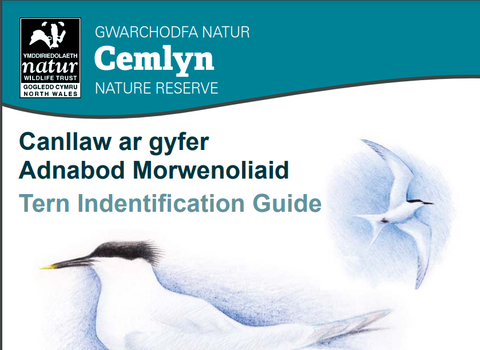
Tern Identification Guide
Cemlyn Nature Reserve holds one of the largest tern colonies in the UK. This guide is designed to help identify the main species likely to be seen here in the Summer months.
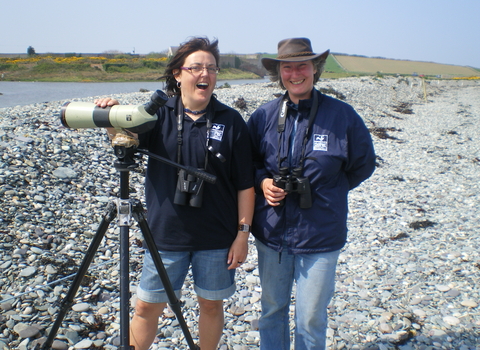
Trudi CLARKE & Dawn WILDE (2008)
Come and meet the terns
Join the wardens for a walk around Cemlyn Bay and a chance to hear all about the tern colony – one of the largest in Wales.

Virtual tour
Discover what makes Cemlyn Nature Reserve such a great place for terns and what we're doing to help them make it their home! Take a virtual tour with our interactive infographic (with thanks to the Roseate Tern LIFE project).
Terns at NWWT Cemlyn nature reserve © Nia Haf Jones
Visit Cemlyn Nature Reserve
Situated on the wild north coast of Anglesey, with its unique, elliptical shingle ridge, Cemlyn is an incredible site to visit. The site is best visited from May through to July when the islands within the lagoon host the nesting colonies of Sandwich, common and Arctic terns. It is the only nesting colony of Sandwich terns in Wales and a true wildlife spectacle – not to be missed!

